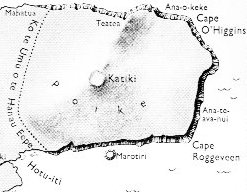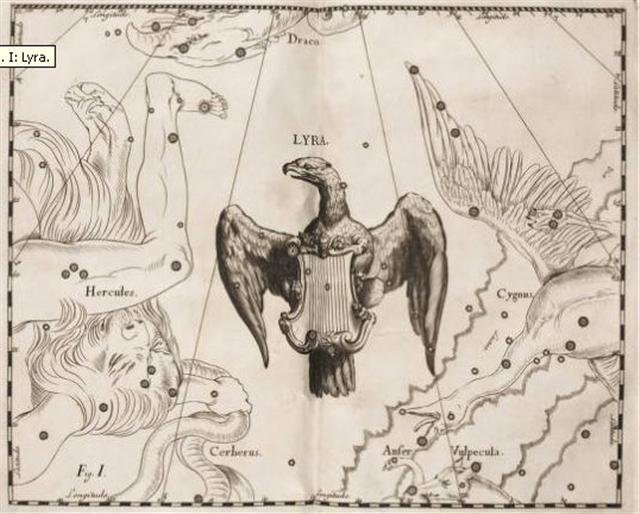We should then move on to 25 Ko Maunga Teatea:
25 Ko Maunga Teatea ought to be about halfway to 50 Hanga Te Pau - if moving withershins and keeping everything in strict order, that is to say. *327 - *122 = *205 (= 365 - 160).
... On the following day, 20 November [324] 1770, Commander José Bustillo took formal possession of Easter Island 'in the name of the King and of Spain, our Lord and Master Don Carlos the third', renaming the island 'San Carlos'. Several hundred Rapanui - probably members of the Koro 'o 'Orongo tribe of the eastern 'Otu 'Iti - observed the ceremony not far from Poike's parasitic cones Parehe, Teatea, and Vai 'a Heva, on the tops of which the Spaniards had planted three crosses. Following three boisterous 'Viva el Rey!' for each cross, the land party let off three salvos of musketry, whereupon the two Spanish vessels San Lorenzo and Santa Rosalia responded with 21 cannon salutes. Spain's foremost historian of the Pacific, Francisco Mellén Blanco, has written of the event: 'The spectacle must have been awe-inspiring for the islanders. The parade of uniformed soldiers; the fluttering flags; the chaplains in their surplices chanting out the litany; the beating of drums, and the trilling of fifes must have left a lasting impression on all the natives who witnessed the procession' ... ... Everywhere the dream soul looked around for a residence for the king. The dream soul went to Maunga Teatea and gave him the name 'Maunga Teatea A Hau Maka O Hiva'. The dream soul of Hau Maka looked around. From Maunga Teatea she looked to Rangi Meamea (i.e., Ovahe). The dream soul spoke the following: 'There it is - ho! - the place - ho! - for the king - ho! - to live (there in the future), for this is (indeed) Rangi Meamea.' ... The Explorers had returned to Hanga Te Pau in day 186 ("July 5), when they in principle - they were far down in the south - could have observed the culmination of Vega, with the culmination of Sirius at the other end of the sky:
Hanga Te Pau was reached by the Explorers in "July 5 (186). This was 186 - 161 = 25 days after "June 10 when they had left Hanga Te Pau. They had arrived to Easter Island in "June 1 (152) and evidently stayed at Hanga Te Pau for 10 days. 186 - 152 = 34. (25 + 34) / 2 = 29½. Presumably hanga implied a place for rest, and the important date would then be when they 'came alive again' - i.e. left the place. Haga. 1. Bay, fishing spot. (Figuratively) he haga o te ákuáku, it is the [evil] spirit's fishing spot, i.e. a place where they hide waiting for people to fall under their power. 2. To want, to love. Ku haga á i te vai, I want water, I am thirsty. Vanaga. 1. Bay, strait, anchorage, strand, beach. P Mq.: hana, haka, small bay, creek, cove. 2. Work, labor, employment, act, affair, creation, design, state, maker, fashion, manufacture, occupation, profession; to do, to make, to construct, to employ, to form, to manufacture, to fashion, to found, to be busy with; haga rakerake, crime; tagata haga ei mea, mercenary; haga no iti, to plot mischief; haga ke, to act contrary; haga takataka, to disjoin; haga nui, difficulty, fatigue, to weary; tuhi ki te haga, to give employment; haga hakahou, to make over, to renew, recovery; haga koroiti, to deal prudently; haga nuinui ke, to overburden. P Pau.: haga, to do, action, work, a deed. Mgv.: haga, aga, work, labor. Mq.: hana, haka, action, act, work, occupation. Ta.: haa, work, to labor, to make. 3. Agreement, conduct, liking, intention, desire, will; to resolve, to permit, to endeavor, to tolerate, to be willing, to wish, to approve; haga ihoiho, fixed desire; haga mai, haga no mai, to agree, to hearken favorably; tae haga, despite, involuntary, to refuse, to renounce; noho hakahaga, apathy. 4. = haka. Pau.: haga = haka. 5. Mgv.: haga, a fish. Mq.: haka, id. 6. Mgv.: haga, a fishtrap. Sa.: faga, a fish-trap, bird-cage. Ma.: hanganoa, a small basket for cooked fish. 7. Mgv.: haga, a measure of a fathom. Ta.: aa, to measure length. Mq.: aka, ana, to measure with the arms. Ma.: whanga, id. Churchill. Hagaava (haga 1 - ava 2), entrance of a harbor. Hagahaga: 1. (haga 2), work. 2. hesitation, to hesitate. Churchill.
Perhaps number 25 for Maunga Teatea in the Makoi list had been chosen in order to remind people not only of the Chinese 25th station Star but also of the distance from the date of the Mad Hatter (186 - 161 = 25): ... The month, which takes its name from Juppiter the oak-god, begins on June 10th and ends of July 7th. Midway comes St. John's Day, June 24th, the day on which the oak-king was sacrificially burned alive. The Celtic year was divided into two halves with the second half beginning in July, apparently after a seven-day wake, or funeral feast, in the oak-king's honour ...
The Explorers went on and reached Rangi Meamea (the place for the king to live) in "July 23 (204):
From 25 Ko Maunga Teatea at the Knot (Ukdah) in "July 2 (183) to Rangi Meamea in "July 23 (204) at Al Kes there were 3 weeks. This information could perhaps be explained by double frames of reference: Presumably 25 Ko Maunga Teatea was the place high up at the top where Vega culminated and our present world once upon a time had been created:
And the name Rangi Meamea could then have implied the radical change due to the position of heliacal Sirius at the time of the Bull - because from there it would have been determined that Sirius (far down) always would rise with the Sun in day 181 (*101).
... The Sothic cycle was based on what is referred to in technical jargon as 'the periodic return of the heliacal rising of Sirius', which is the first appearance of this star after a seasonal absence, rising at dawn just ahead of the sun in the eastern portion of the sky. In the case of Sirius the interval between one such rising and the next amounts to exactly 365.25 days - a mathematically harmonious figure, uncomplicated by further decimal points, which is just twelve minutes longer than the duration of the solar year ... In ancient Egypt they thought Sirius was behind the yearly rise of the Nile ... the seasonal cycle, throughout the ancient world, was the foremost sign of rebirth following death, and in Egypt the chronometer of this cycle was the annual flooding of the Nile ... In a way the Explorers were able to move in time-space - like the Inka Wayna Qhapaq: ... Space and time are a single, related concept in Runasimi [the language of the Inca people], represented by one word, pacha, which can also mean 'world' and 'universe'. The image of time familiar to Waman Puma was static and spatial: one could travel in time as one travels over earth - the structure, the geography, remaining unchanged. To him it does not matter that he shows Inka Wayna Qhapaq, who died in 1525, talking to Spaniard, who did not arrive until 1532. Wayna Qhapaq was the last Inca to rule an undivided empire: he is therefore the archetype, and it must be he who asks the Spaniards. 'Do you eat gold?' In Andean thought both world and time were divided into four sectors or directions unified under a presiding fifth principle. The Tawantinsuyu - 'the indivisible four quarters' - was unified and presided over by Cusco, the center. Similarly, history was divided into four previous ages, presided over by a fifth, the present. In his book, Waman Puma organizes the history of both Old and New worlds according to this scheme. The Old Testament and the pre-Inca times are each divided into four equivalent and parallel ages. The 'present' age in Peru begins with the appearance of Manku Qhapaq, the first Inca, a being of supernatural origin. And in the Old World the 'present' starts with the birth of Jesus Christ ...
... In the present context 'mouth' has an additional connotation, given that it refers in part to Heart of Earth, the deity called 'Mundo' today. This is the great Mesoamerican earth deity, the ultimate swallower of all living beings, depicted in Classic Mayan art (in the Palenque relief panels, for example) as an enormous pair of jaws upon whose lips even the feet of great lords must rest in precarious balance, and into whose throat even great lords must fall. Turning to the contemporary scene, daykeepers who visit the main cave beneath the ruins of Rotten Cane, the last Quiché capital, speak of the danger of falling into 'the open mouth of the Mundo' there, which is said to be more than four yards wide ...
... The Egyptian Bull's Thigh was high up in the center of the sky (at the Top of the Roof so to say):
... Ishtar, scorned, goes up to heaven in a rage, and extracts from Anu the promise that he will send down the Bull of Heaven to avenge her. The Bull descends, awesome to behold. With his first snort he downs a hundred warriors. But the two heroes tackle him. Enkidu takes hold of him by the tail, so that Gilgamesh as espada can come in between the horns for the kill. The artisans of the town admire the size of those horns: 'thirty pounds was their content of lapis lazuli'. (Lapis lazuli is the color sacred to Styx, as we have seen. In Mexico it is turquoise.) Ishtar appears on the walls of Uruk and curses the two heroes who have shamed her, but Enkidu tears out the right thigh of the Bull of Heaven and flings it in her face, amidst brutal taunts. It seems to be part of established procedure in those circles. Susanowo did the same to the sun-goddess Amaterasu, and so did Odin the Wild Hunter to the man who stymied him ... |
|||||||||||||||||||||||||||||||||||||||||||||||||||||||||||||||||||||||||||||||||||||||||||||||||||||||||||||||||||||||||||||||||||||||||||||||||||||||||||||||||||||||||||||||||||||||||||||||||||||||||||||||||||||||||||||||||||||||||||||||||||||||||||||||||||||||||||||||||||||||||||||||||||||||||||||||||||||||||||||||||||||||||||||||||||||||||||||||||||||||||||||||||||||||||||||||||||||||||||||||||||||||||||















